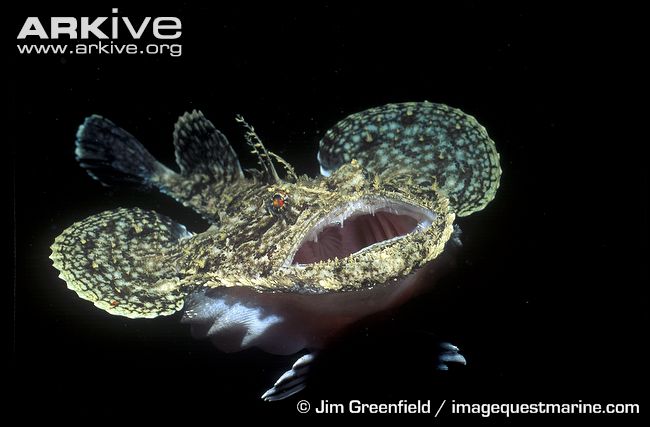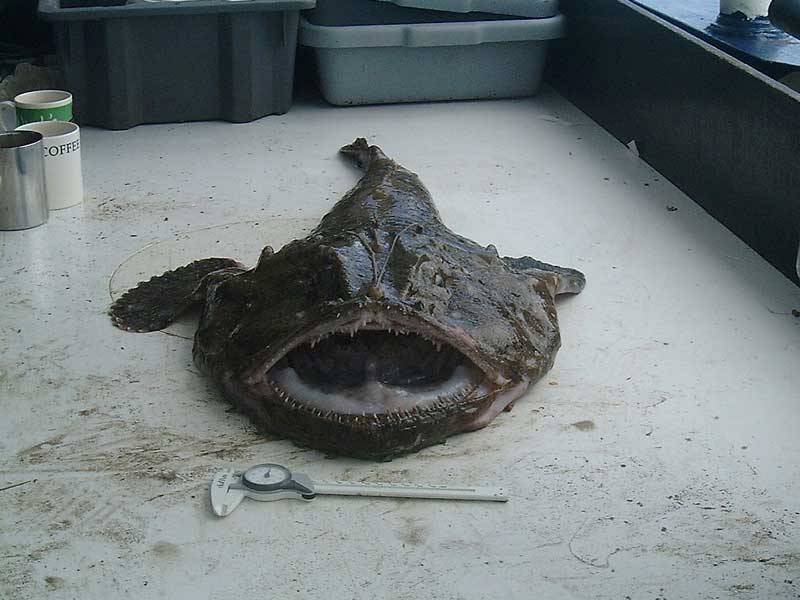Friends and Enemies- They're All the Same... Right?
Lophius piscatorius has a very unique way of interacting with the organisms that come into its life. It often has multiple mates, who are all parasitic, uses a bioluminescent fishing rod to attract prey, and is often caught on accident by humans.
 When an anglerfish is born it has two fates: become a
thriving top predator in the deep sea, or a parasite, completely
dependent on its host, only used for its gonads. This fate is
determined based on the sex of the fish. Male Lophius
piscatorius’ only goal in life is to find a female and will
eventually die if he does not. Male anglerfish are born into a
short free-living stage of life with large nostrils and eyes.
Since they cannot feed on their own, they use these specialized
structures to find a female- looking and smelling the ocean for
her. On the slight chance it finds a mate in the dark depths of
the sea, male anglerfish latch on to the female with its teeth.
Eventually it fuses with her losing all parts of his
independence; his circulatory and digestive system completely
fuses with the female. He gets all nutrients and other living
essentials from the female. Luckily for the female, she has
permanent sperm bank that she can use any time for
reproduction, and a mate that
will never leave her. It is not unheard of for female L.
piscatorius to have multiple males attached to her- talk
about clingy! (Doughton 2006) Although males are the most common
type of
parasites, some others include nematodes and copepods (Abollo
et. al. 2001). One other symbiotic relationship the anglerfish
has is with a bioluminescent bacteria that helps attract prey,
predators and parasites. This colony bacteria, which is most
likely a part of the genus Vibro, is nourished by the
food it helps attract. In turn it continues to help L.
piscatorius find a meal (Lin et. al. 2009). To learn more
about this interesting relationship
click here.
When an anglerfish is born it has two fates: become a
thriving top predator in the deep sea, or a parasite, completely
dependent on its host, only used for its gonads. This fate is
determined based on the sex of the fish. Male Lophius
piscatorius’ only goal in life is to find a female and will
eventually die if he does not. Male anglerfish are born into a
short free-living stage of life with large nostrils and eyes.
Since they cannot feed on their own, they use these specialized
structures to find a female- looking and smelling the ocean for
her. On the slight chance it finds a mate in the dark depths of
the sea, male anglerfish latch on to the female with its teeth.
Eventually it fuses with her losing all parts of his
independence; his circulatory and digestive system completely
fuses with the female. He gets all nutrients and other living
essentials from the female. Luckily for the female, she has
permanent sperm bank that she can use any time for
reproduction, and a mate that
will never leave her. It is not unheard of for female L.
piscatorius to have multiple males attached to her- talk
about clingy! (Doughton 2006) Although males are the most common
type of
parasites, some others include nematodes and copepods (Abollo
et. al. 2001). One other symbiotic relationship the anglerfish
has is with a bioluminescent bacteria that helps attract prey,
predators and parasites. This colony bacteria, which is most
likely a part of the genus Vibro, is nourished by the
food it helps attract. In turn it continues to help L.
piscatorius find a meal (Lin et. al. 2009). To learn more
about this interesting relationship
click here.
With so much baggage one might wonder where the anglerfish
fits in on the food chain, and the answer is: pretty high.
L. piscatorius is a top predator in its
habitat. It has
adapted very specialized structures that set it apart from many
other organisms. The anglerfish has a bioluminescent fishing rod
that lures prey near its mouth. Once the mesmerized prey gets
close enough to the anglerfish, she opens up her mouth creating
a vacuum-like suction that pulls the prey in, all in less than a
second. Not only can L. piscatorius capture prey
quickly, it can also eat fish larger than itself thanks to an
expandable stomach and retractable jaws (Rice 2010). Its diet primarily consists of
benthic crustaceans, mollusks and bony fishes. It is also known
to eat rays and eels (Croizer 1985)! To see the Anglerfish in
action check out this amazing
video!
 Even though the anglerfish is a top predator, every organism
has some areas of threat. The most vulnerable part of any L.
piscatorius’ life is before full development, it is smaller
and much easier for other predators to attack. Natural predation
occurs on some anglerfish, but fishing is the principal threat
to this organism. Many times the angler is not intentionally
intended to be harmed, but often ends up as collateral damage.
L. piscatorius is usually caught on accident by
commercial trawl nets; it can’t survive the long journey to the
surface of the water so it dies before fishermen get the chance
to throw it back. Even if an anglerfish is not caught in one of
the trawl nets, their prey are. Deep-sea fishing is not highly
regulated; therefore, anglerfish habitats have the potential to
be overfished causing depletion in the amount of prey available (ARKive).
Even though the anglerfish is a top predator, every organism
has some areas of threat. The most vulnerable part of any L.
piscatorius’ life is before full development, it is smaller
and much easier for other predators to attack. Natural predation
occurs on some anglerfish, but fishing is the principal threat
to this organism. Many times the angler is not intentionally
intended to be harmed, but often ends up as collateral damage.
L. piscatorius is usually caught on accident by
commercial trawl nets; it can’t survive the long journey to the
surface of the water so it dies before fishermen get the chance
to throw it back. Even if an anglerfish is not caught in one of
the trawl nets, their prey are. Deep-sea fishing is not highly
regulated; therefore, anglerfish habitats have the potential to
be overfished causing depletion in the amount of prey available (ARKive).
 Although
not as common, sometimes Anglerfish are intentionally fished.
Their tails are seen as a
delicacy in Japanese and Korean cultures so they are sometimes
caught and sold on fish markets; they are said to taste like
lobster (Thompson 2011)! Pictured to the right is anglerfish
liver with scallions and sea salt. There are even some
recipes online.
One of my personal favorites is the
butter fried Anglerfish with shrimp and chantarelles. Yummy!
Although
not as common, sometimes Anglerfish are intentionally fished.
Their tails are seen as a
delicacy in Japanese and Korean cultures so they are sometimes
caught and sold on fish markets; they are said to taste like
lobster (Thompson 2011)! Pictured to the right is anglerfish
liver with scallions and sea salt. There are even some
recipes online.
One of my personal favorites is the
butter fried Anglerfish with shrimp and chantarelles. Yummy!
There is not much information on the abundance of the anglerfish due to its deep-sea habitat. People should be especially sensitive to organisms they don’t know as much about. In fact, they may be making a huge impact on the base of the ecosystem!
Return to the Homepage
